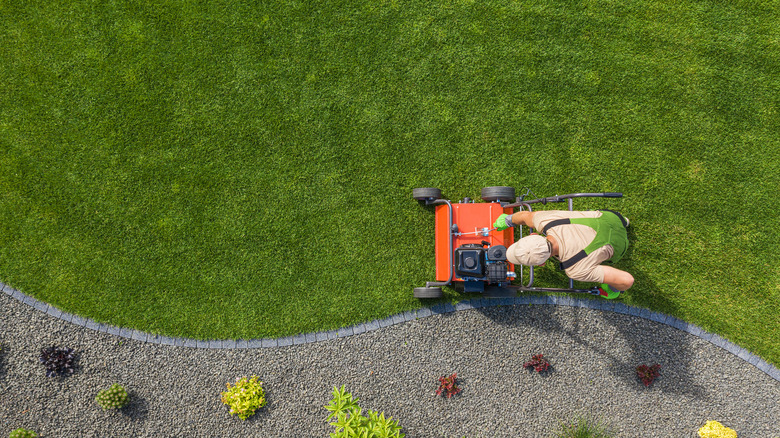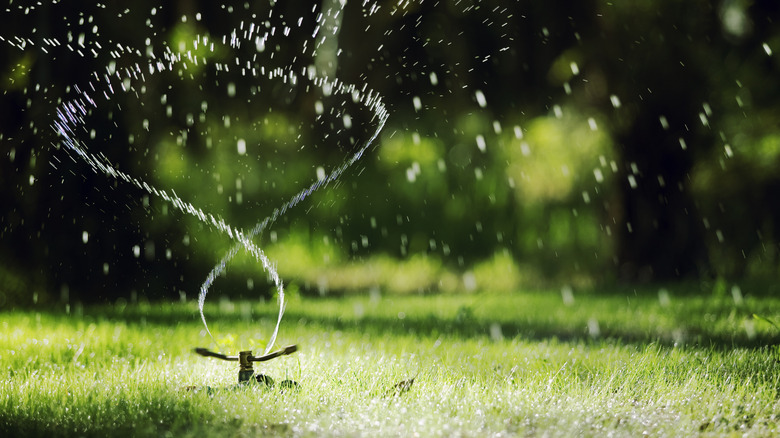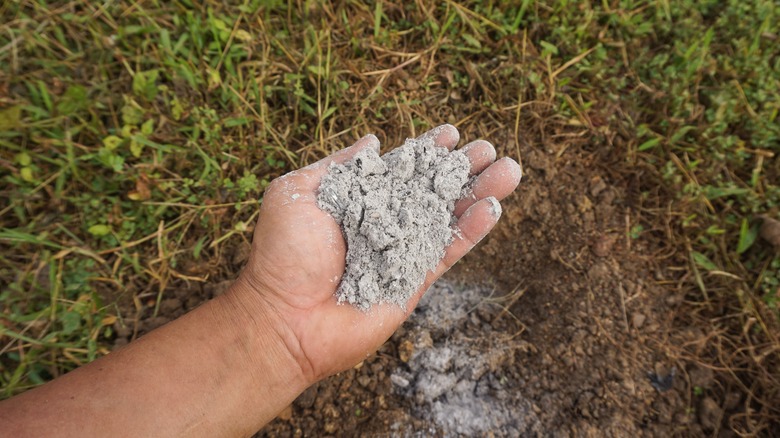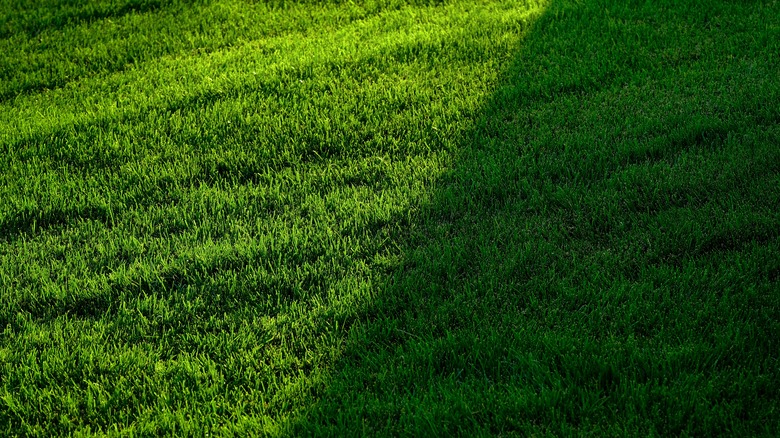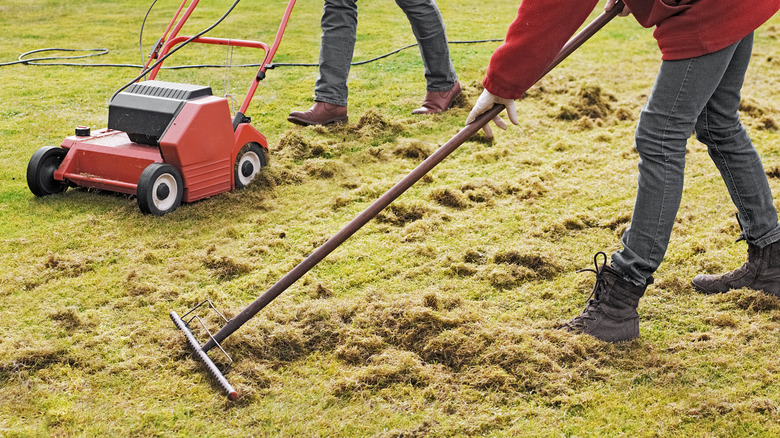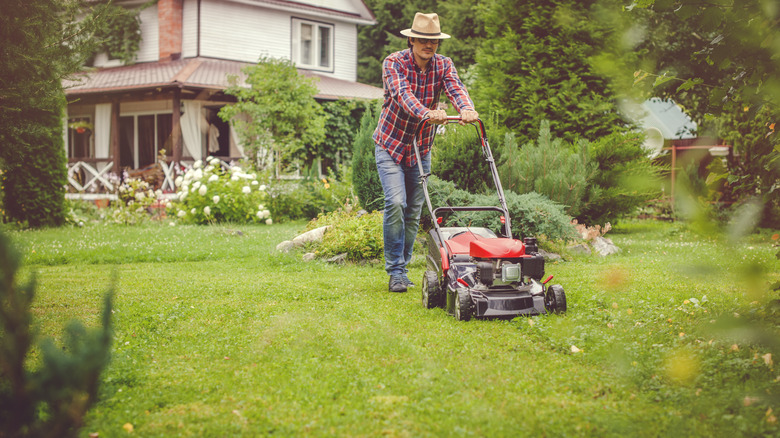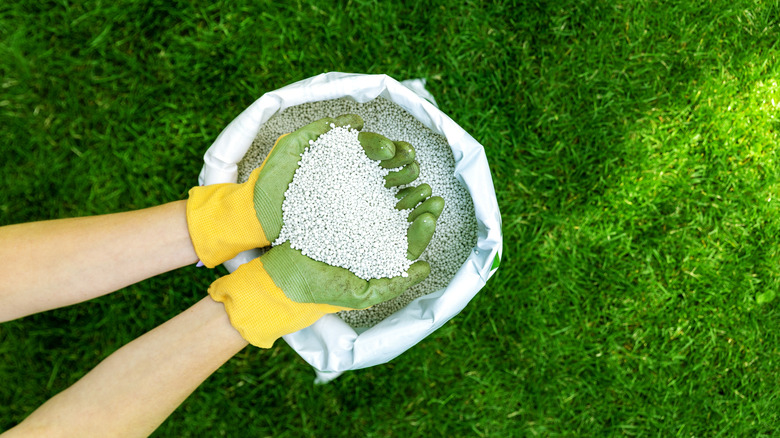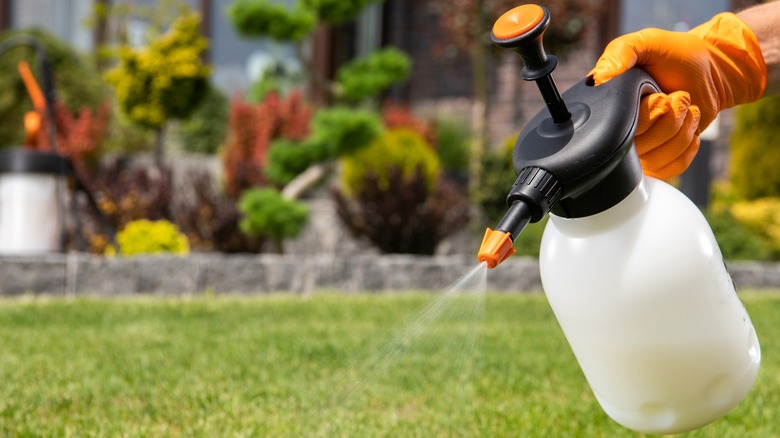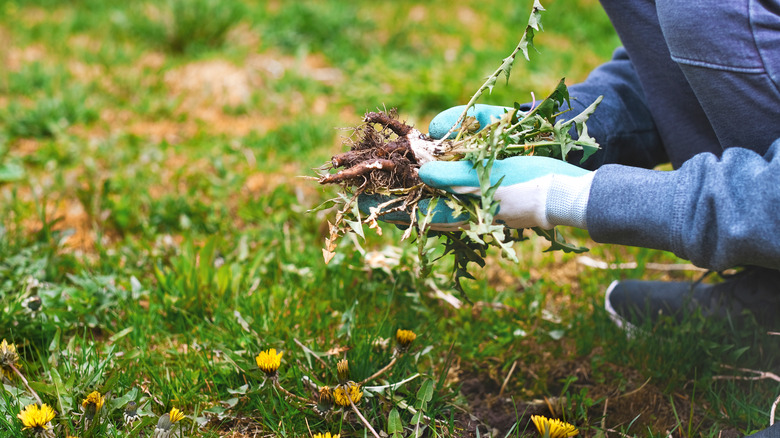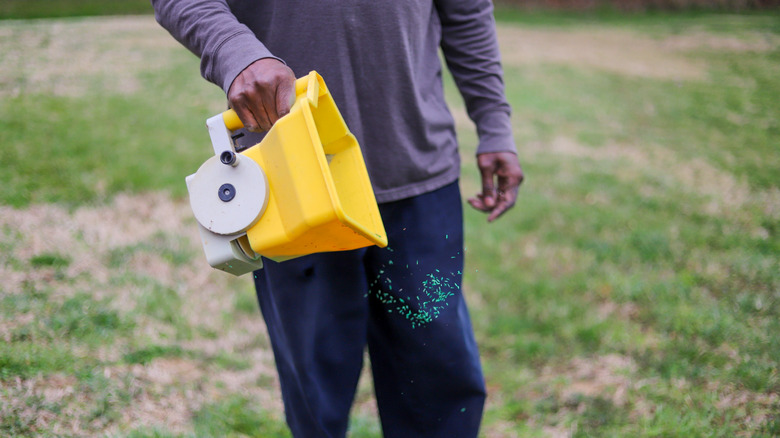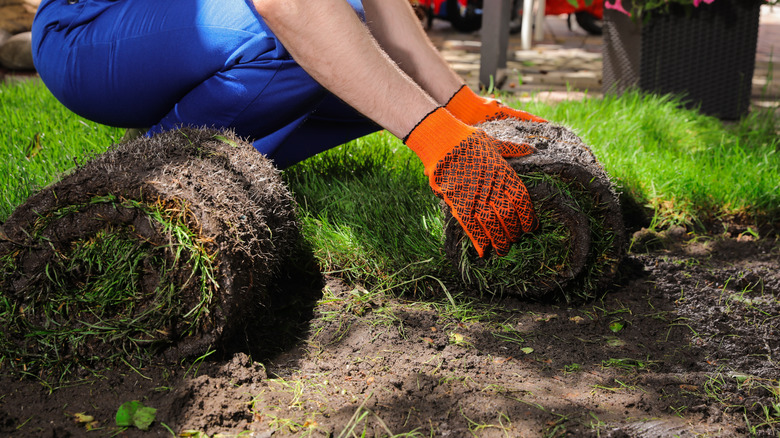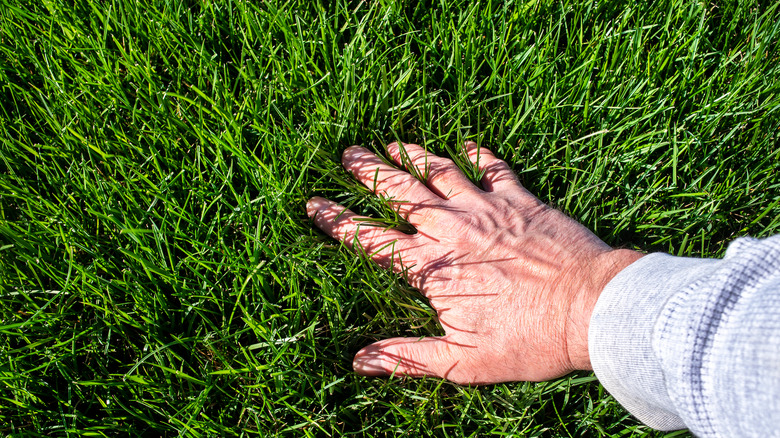Tips For Repairing The Thinning Grass In Your Yard
A yard with wispy, thin blades of grass and bare patches is a far cry from the immaculate lawn you envisioned when you were sowing the seeds. Apart from the visual aesthetic and what a patchy lawn might say about your green thumb, it also indicates trouble at some level. It could be poor care on your part for not properly feeding, watering, and mowing the turf grass. Or the culprit could be the seeds themselves — either they're of inferior quality, or they come mixed with the seeds of invasive plants.
However, patchy lawns can be annoyingly difficult to fix because they have many root causes. These can be traced back to the soil texture, the absence of sunlight, or the presence of pests and diseases. If you want your yard to match your expectations, you will have to get your hands dirty in more ways than one. On the bright side, with a few adjustments to your maintenance routine and a little trial and error, you can repair your lawn and bring it back to its former glory. The following tips address the different causes of thinning grass and what you need to do to remedy the situation.
Aerate and amend compacted soil
Thinning grass is a common occurrence on a lawn with compact and poorly aerated soil. Turfgrass has root systems that range from 6 inches to 1 foot long. But even with a root ball so close to the surface, the plant struggles to grow in clayish or heavy soil. Such soil is prone to compaction, which hinders the development of the roots and pushes out air needed by beneficial bacteria. Amending compact soil loosens its texture for better root growth, and healthy and thick grass. To solve the compaction problem, break the topsoil with a rototiller, then add compost to the top 3 inches of the soil and mix it with a rake.
Aerating the turf is another way to fix compact soil and spotty grass. It allows oxygen, moisture, and nutrients to reach the roots of the grasses. To aerate a small lawn, use a spading fork or aerating sandals to make holes 4 inches deep in the soil. A core aerator is needed for large yards. Soil amendment should be implemented before you sow the grass seeds on the lawn. Applying it to a patch on the lawn will kill any turfgrass growing there. However, aeration harms some, but not all, of the plants. You can aerate cool-season turfgrasses in the fall and warm-season varieties in late spring or early summer.
Adjust how you water your turf
With so many grass varieties having different moisture needs, it's easy to make an irrigation mistake that leads to dead turf and patchy lawns. One of the main reasons grass grows unevenly in the yard is due to inadequate watering methods. Checking the soil in the areas with thinning grass gives you a clear idea of mistakes in irrigation. If the soil is dry, then drought is to blame for the bare areas. But, if the soil is soggy and squishy, you're overwatering the yard. During the spring and summer, your turf needs 1 inch of water a week on average, or about 0.6 gallons of water per square foot. The best time of day to water your lawn is early in the morning. As the weather cools down, the grass' moisture needs diminish as well.
But the amount of water the grass is getting is only half the problem. The other half has to do with how you irrigate your lawn. Shallow and frequent watering promotes shallow grass roots. You should limit the irrigation to once or twice a week, and water deeply to encourage deep roots. Check the watering systems to make sure that the water is dispersed evenly across the yard. This helps avoid creating water puddles, which leads to fungal and pest infestation.
Fix pH levels
Over time, the soil in many lawns turns acidic. Rainfall tends to change the chemical composition of the topsoil in favor of acidic nutrients. Fertilizers rich in ammonium also lower the pH levels. Most turfgrasses thrive in slightly acidic soil with pH readings between 6.5 and 7. Any deviation from these ranges renders the nutrients unusable, which causes thinning grass and spotty lawns. Additionally, acidic soil can get too toxic for grass with high concentrations of manganese and aluminum. To repair a patchy yard, test the pH levels in the topsoil and apply the treatment either in the spring or fall.
For acidic soil, increase the pH reading by applying lime or wood ashes. In the fall, use a fertilizer spreader to sprinkle pulverized lime all over the lawn, and then water it. Wood ashes are less effective than lime and should be used with caution, as they could damage the roots of established grass. As for alkaline soil, both aluminum sulfate and sulfur will bring down the pH levels. However, aluminum sulfate works faster and is a lot safer to use on established lawns. Sulfur takes more time to increase acidity and can cause leaf burn when it comes in contact with the blades of grass.
Switch to shade-tolerant grass varieties
The majority of turfgrass species need sunlight for healthy growth. When the grass becomes weak and prone to diseases in a specific part of the lawn, check whether that area is getting six hours of sunlight a day. If it happens to fall under the shadow of a tree or a building, chances are sun deprivation is the cause of thinning grass. You need to reseed the shady area with grass varieties that make do with little sunlight. Shade-tolerant grasses such as tall fescue, hard fescue, ryegrass, slender creeping fescue, and Kentucky bluegrass are cool-season species. Meanwhile, St. Augustine grass, zoysia grass, bahiagrass, and centipedegrass are warm-season grasses ideal for lawns with light shade.
Some combinations of these varieties work well together to grow turfgrass with high tolerance to shade. Kentucky bluegrass and fine fescue, in equal portions, do better in shade than either of those varieties individually. Adding a small portion of other fescue cultivars to the mix can make the lawn more hardy to low maintenance. To help shade-tolerant grass grow, avoid excessive foot traffic in those areas, and prune trees that cast a shadow to allow more sunlight in. When mowing the grass in shaded areas, raise the mower blade between 1/2 to 1 inch higher to promote better leaf sun exposure.
Dethatch the lawn regularly
In an established lawn, a layer of undecomposed grass clippings, stems, and roots often forms between the turfgrass and the soil. This is thatch, and when it becomes thick, it keeps the moisture and nutrients from getting to the roots and becomes infested with pathogens. This is the reason that the grass is thinning on the lawn even when it's growing in the best conditions. Before you can dethatch your turf, you'll need to mow the grass, remove debris, and water the lawn well. A dethatching rake is ideal for removing a thin layer of it in a small area. But if a large lawn is covered with thick thatch, then power rakes or vertical mowers are the right tools for the job.
If you notice that the buildup has grown above 1/2 inch thick, then you know it's time to jump into immediate action. It should be done in the spring or fall. However, keep in mind that it can harm the turfgrass, especially when dealing with thick thatch. Power tools could turn up the soil and pull out the established grass along with the thatch. To protect the turf, adjust the tines of the power rake or vertical mower so that it only grabs a thin layer of thatch at every pass. And to control thatch development, aerate the soil regularly and don't let it get too acidic.
Practice better mowing techniques
Mowing the grass is both an art and a science. Done right, it promotes the health and vigor of the lawn. However, wrong mowing techniques coupled with poor timing and inadequate tools could all damage the turf and cause thinning yards. Knowing when to cut the grass is just as important as knowing how to do it. In general, you should set the mower blades to cut only the top 1/3 of the turfgrass. If the ideal height for the grass is 2 inches, mow it when it grows to 3 inches high. The mower should have sharp blades to prevent the grass tips from turning brown and the turf from getting diseases. Mixing the mowing patterns with every pass ensures that you get all the outgrown grass.
To get the most out of each mow, avoid mowing a wet lawn. It causes grass clippings to clump, and a heavy mower would get into ruts more frequently. Also, consider leaving the clippings on the lawn to serve as both mulch and fertilizer. However, if the mowing produces a large amount of clippings, then you need to bag them.
Fertilize at the right time and in the recommended doses
Between the mowing, and people and pets walking and frolicking in the yard, your grass needs all the help it can get to stay healthy throughout all this activity. Fertilizers are important for a healthy yard, but overfertilization can kill the grass. Most turfgrass varieties need nitrogen more than potassium or phosphorus to grow their leaves back after mowing and maintain a dense texture. Water-insoluble nitrogen fertilizers with 30% to 60% concentrations are recommended for lawns. The slow-release plant food doesn't burn the roots or contaminate the environment. The average lawn needs fertilization once a year to be applied in early fall. Each application shouldn't exceed 1 pound of nitrogen for every 1,000 square feet.
To avoid overfertilizing the turf, test the soil before the application. If the soil is rich in organic materials, the lawn needs less nitrogen in the fertilizer. The same goes for leaving grass clippings on the lawn after mowing. The clippings break down and provide the roots with nitrogen. And lastly, stay away from spring fertilizing. It promotes leaf growth but causes stunted roots, which makes the grass vulnerable to diseases and less tolerant of drought.
Get rid of pests and treat diseases
Eliminating pests and treating diseases give thinning grass a chance to recover and grow back. Pests of different shapes and sizes weaken and kill the turfgrass, creating barren patches on the lawn. Grubs, for example, live in the soil and feed on the roots, causing dead spots in your lawn. They include white grubs, billbug grubs, and Japanese beetle larvae. The adult versions of the grubs include billbugs, European chafers, and Japanese beetles. Along with fiery skippers, cutworms, sod webworms, and chinch bugs, they feed on the stems and leaves, and transmit pathogens to the yard. Proper watering, fertilizing, dethatching, and mowing are the best methods to get rid of these pests. In cases of severe infestations, identify the culprits and apply pesticides.
Diseases can wreak havoc on the lawn and create patches of discoloration and dying grass. Some of the common turf diseases include dollar spot, fairy ring, Fusarium blight, gray leaf spot, pink snow mold, Pythium blight, and Rhizoctonia blight. As with fighting off pests, applying best practices for turf care and maintenance prevents these diseases. Fungicides can be used to treat large lawn infections.
Eliminate weeds and invasive plants
A well-maintained yard is the best way to manage weeds, and the opposite is true as well. Invasive plants spread on a neglected lawn where the grass is thin, further choking the turf. Some weeds look similar to grass and are hard to spot. Grassy weeds include crabgrass, quackgrass, doveweed, dallisgrass, and nutsedge, among others. But others, like broadleaf weeds, stick out with large leaves and striking colors. The most common broadleaf species in the lawn are dandelion, dollarweed, common chickweed, henbit, prostrate spurge, and white clover. In a small yard, you can pull the unwanted plants out by hand or use a weed puller. But if the weed infestation is severe or you're dealing with a large infected area, then herbicides can help eliminate the invasive plants.
Pre-emergence herbicides are applied in the spring and fall to prevent undesirable flora from establishing in the soil. Post-emergent herbicides treat specific vegetation and should be applied to the weeds as needed. On the downside, herbicides can harm the turf and damage the grass. That said, there are better ways to kill weeds without killing your yard.
Reseed large, bare patches
When large areas in the yard are left bare, the turfgrass can't grow back and cover them. Hence, the need to reseed. The process is similar to the normal seeding of the lawn but with a few extra steps. After selecting the right seeds for the job, go down to the bare patches and pull out any grass and weeds still left. Since the established grass can crowd out the seedlings, mow the lawn before you start reseeding. Next, use a rake to loosen the soil and remove debris. If the soil is compacted, aerate, amend, and add organic materials as necessary. After spreading the seeds, rake the soil again to improve the seed-to-soil contact. Finally, water the treated area enough to get it moist.
You'll need to mow the lawn while the seedlings are growing, otherwise, the new grass won't survive the competition for nutrients and water. If the soil dries out immediately after reseeding, the seeds won't germinate. Shallow watering is recommended once or twice a day until the seedlings are 2 inches high.
Replace small, thin patches with sod for faster growth
When you're pressed for time and don't have the patience or inclination to nurture grass from seeds, sod is the way to go. Sod repairs small thin patches in the yard and blends in quickly since it establishes its roots within a couple of weeks. To install sod properly, remove all the remaining grass and weeds in the thinning patch. Then prepare the soil the same way you'd do when seeding or reseeding the lawn. After getting the soil a little moist, lay the sod and stagger the edges. You can install this ready-made turf in the yard any time of the year as long as the soil isn't frozen.
To help the new turfgrass establish, avoid using herbicides to kill the previous grass in the soil. On the other hand, sod has its disadvantages since it doesn't come with many grass variety options. Also, improper installation can lead to shrinking turf which paves the way for weeds to grow.
Choose the right grass for your region and microclimate
When the grass is patchy in your yard, there's a chance it could be the wrong species for your region. Cool-season grass can handle daytime temperatures as low as 55 degrees F. But it will go dormant if the temperature climbs to 90 degrees F. Meanwhile, warm-season species will stop growing if the average temperature drops below 65 degrees F for a few days in a row. Buying the grass seeds from a local nursery in your area is preferable to getting the seeds from sketchy sources online. Also, make sure that both the seed species and variety are stated on the label.
If you're not sure how a certain cultivar will perform in your region, the National Turfgrass Evaluation Program provides a lot of relevant information. It has a vast database covering major grass varieties and how they fare under different conditions. And since the turfgrass will stay on the lawn for years to come, it's worth it to get high-quality seeds. Cheap seeds can have inferior cultivars or even annual species mixed in.


